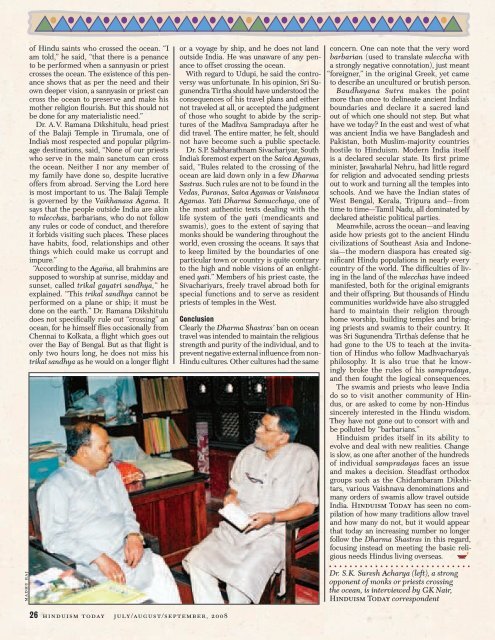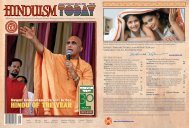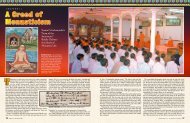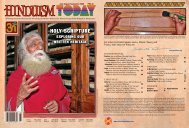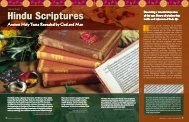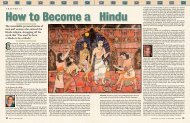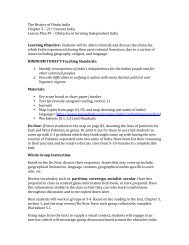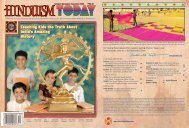Hinduism Today July 2008 - Cover, Index, Front Articles
Hinduism Today July 2008 - Cover, Index, Front Articles
Hinduism Today July 2008 - Cover, Index, Front Articles
- No tags were found...
You also want an ePaper? Increase the reach of your titles
YUMPU automatically turns print PDFs into web optimized ePapers that Google loves.
of Hindu saints who crossed the ocean. “Iam told,” he said, “that there is a penanceto be performed when a sannyasin or priestcrosses the ocean. The existence of this penanceshows that as per the need and theirown deeper vision, a sannyasin or priest cancross the ocean to preserve and make hismother religion flourish. But this should notbe done for any materialistic need.”Dr. A.V. Ramana Dikshitulu, head priestof the Balaji Temple in Tirumala, one ofIndia’s most respected and popular pilgrimagedestinations, said, “None of our priestswho serve in the main sanctum can crossthe ocean. Neither I nor any member ofmy family have done so, despite lucrativeoffers from abroad. Serving the Lord hereis most important to us. The Balaji Templeis governed by the Vaikhanasa Agama. Itsays that the people outside India are akinto mlecchas, barbarians, who do not followany rules or code of conduct, and thereforeit forbids visiting such places. These placeshave habits, food, relationships and otherthings which could make us corrupt andimpure.”“According to the Agama, all brahmins aresupposed to worship at sunrise, midday andsunset, called trikal gayatri sandhya,” heexplained. “This trikal sandhya cannot beperformed on a plane or ship; it must bedone on the earth.” Dr. Ramana Dikshituludoes not specifically rule out “crossing” anocean, for he himself flies occasionally fromChennai to Kolkata, a flight which goes outover the Bay of Bengal. But as that flight isonly two hours long, he does not miss histrikal sandhya as he would on a longer flightor a voyage by ship, and he does not landoutside India. He was unaware of any penanceto offset crossing the ocean.With regard to Udupi, he said the controversywas unfortunate. In his opinion, Sri SugunendraTirtha should have understood theconsequences of his travel plans and eithernot traveled at all, or accepted the judgmentof those who sought to abide by the scripturesof the Madhva Sampradaya after hedid travel. The entire matter, he felt, shouldnot have become such a public spectacle.Dr. S.P. Sabharathnam Sivachariyar, SouthIndia’s foremost expert on the Saiva Agamas,said, “Rules related to the crossing of theocean are laid down only in a few DharmaSastras. Such rules are not to be found in theVedas, Puranas, Saiva Agamas or VaishnavaAgamas. Yati Dharma Samucchaya, one ofthe most authentic texts dealing with thelife system of the yati (mendicants andswamis), goes to the extent of saying thatmonks should be wandering throughout theworld, even crossing the oceans. It says thatto keep limited by the boundaries of oneparticular town or country is quite contraryto the high and noble visions of an enlightenedyati.” Members of his priest caste, theSivachariyars, freely travel abroad both forspecial functions and to serve as residentpriests of temples in the West.ConclusionClearly the Dharma Shastras’ ban on oceantravel was intended to maintain the religiousstrength and purity of the individual, and toprevent negative external influence from non-Hindu cultures. Other cultures had the sameconcern. One can note that the very wordbarbarian (used to translate mleccha witha strongly negative connotation), just meant“foreigner,” in the original Greek, yet cameto describe an uncultured or brutish person.Baudhayana Sutra makes the pointmore than once to delineate ancient India’sboundaries and declare it a sacred landout of which one should not step. But whathave we today? In the east and west of whatwas ancient India we have Bangladesh andPakistan, both Muslim-majority countrieshostile to <strong>Hinduism</strong>. Modern India itselfis a declared secular state. Its first primeminister, Jawaharlal Nehru, had little regardfor religion and advocated sending priestsout to work and turning all the temples intoschools. And we have the Indian states ofWest Bengal, Kerala, Tripura and—fromtime to time—Tamil Nadu, all dominated bydeclared atheistic political parties.Meanwhile, across the ocean—and leavingaside how priests got to the ancient Hinducivilizations of Southeast Asia and Indonesia—themodern diaspora has created significantHindu populations in nearly everycountry of the world. The difficulties of livingin the land of the mlecchas have indeedmanifested, both for the original emigrantsand their offspring. But thousands of Hinducommunities worldwide have also struggledhard to maintain their religion throughhome worship, building temples and bringingpriests and swamis to their country. Itwas Sri Sugunendra Tirtha’s defense that hehad gone to the US to teach at the invitationof Hindus who follow Madhvacharya’sphilosophy. It is also true that he knowinglybroke the rules of his sampradaya,and then fought the logical consequences.The swamis and priests who leave Indiado so to visit another community of Hindus,or are asked to come by non-Hindussincerely interested in the Hindu wisdom.They have not gone out to consort with andbe polluted by “barbarians.”<strong>Hinduism</strong> prides itself in its ability toevolve and deal with new realities. Changeis slow, as one after another of the hundredsof individual sampradayas faces an issueand makes a decision. Steadfast orthodoxgroups such as the Chidambaram Dikshitars,various Vaishnava denominations andmany orders of swamis allow travel outsideIndia. <strong>Hinduism</strong> <strong>Today</strong> has seen no compilationof how many traditions allow traveland how many do not, but it would appearthat today an increasing number no longerfollow the Dharma Shastras in this regard,focusing instead on meeting the basic religiousneeds Hindus living overseas. ∏πThe Kindly ElephantKrishna’s Subhadra is a hitwith kids and adults alikeubhadra’s day begins with a bath followed by abreakfast of cornmeal and kooragu flour. At 9am, after thetemple puja, she receives a second meal—cooked rice seasonedwith turmeric provided by the temple kitchen. A continualsupply of palm leaves is available the rest of the day,plus whatever devotees offer. The 15-year-old elephant’s daily dutiesinclude leading processions once or twice, and giving blessings eachevening from 4pm to 8pm. On festival days she leads the templechariot and things get a bit more hectic. From time to time she mustalso greet visiting dignitaries. Unlike elephant duties in Kerala, sheis not required to carry the priests on her back while circumambulatingthe temple.Devotees come to see Subhadra after worshiping LordKrishna in the temple. She is trained to give a blessingwhen offered a small coin which she adroitly collects withthe tip of her trunk and passes to Unnikrishnan, her fulltimemahout. Unnikrishnan, who comes from a family ofmahouts, has cared for Subhadra for seven years. “She isvery obedient and follows my commands without hesitation,”he volunteers. Her good health and clean surroundingsare testament to his dutiful care.Subhadra is very considerate of small children, gently touchingthem on their head with her trunk, which feels like a very largeand dry tongue. Although she only gives the blessing when given acoin, she happily accepts food, such as bananas—which she does notshare with her mahout but eats straight away.Subhadra: The 15-year-old elephant blesses two children by lightlytapping them on the head with her trunk under the watchfulgaze of mahout Unnikrishnan. In the background are two effigiesthat are carried in the Paryaya procession.madhu rajDr. S.K. Suresh Acharya (left), a strongopponent of monks or priests crossingthe ocean, is interviewed by GK Nair,<strong>Hinduism</strong> <strong>Today</strong> correspondentmadhu raj26 hinduism today july/august/september, <strong>2008</strong>july/august/september, <strong>2008</strong> hinduism today 27


